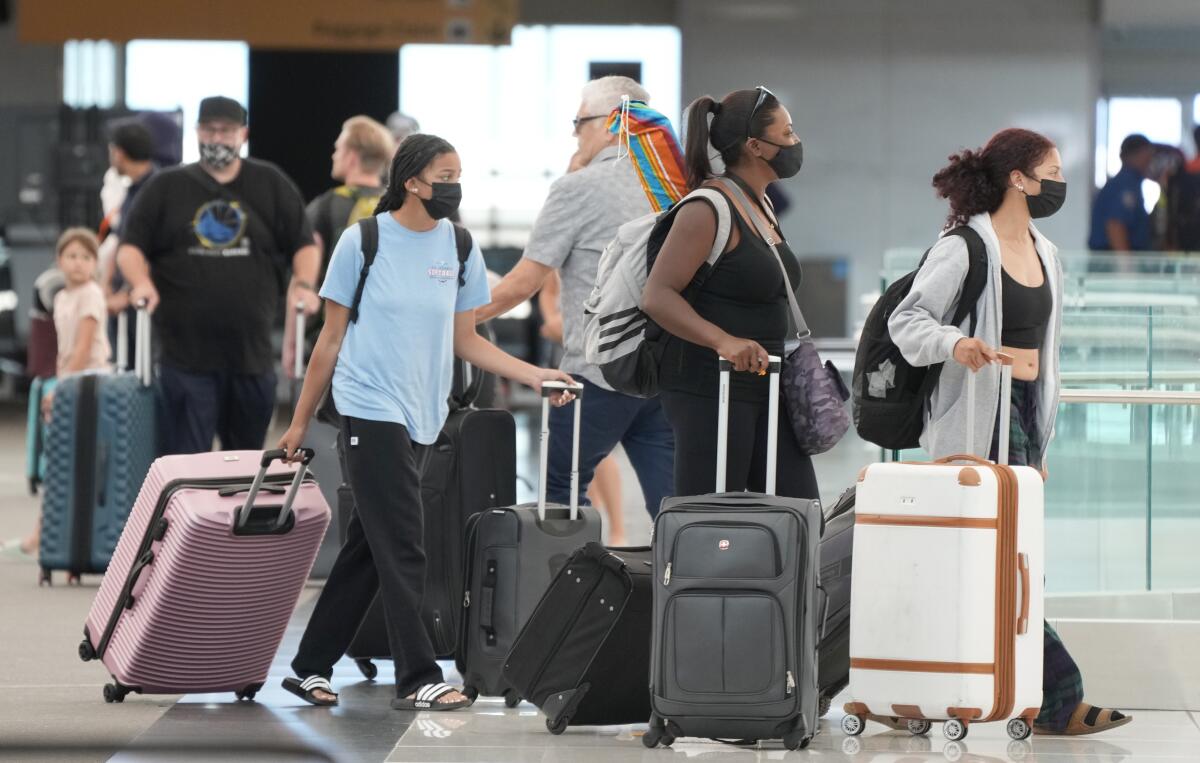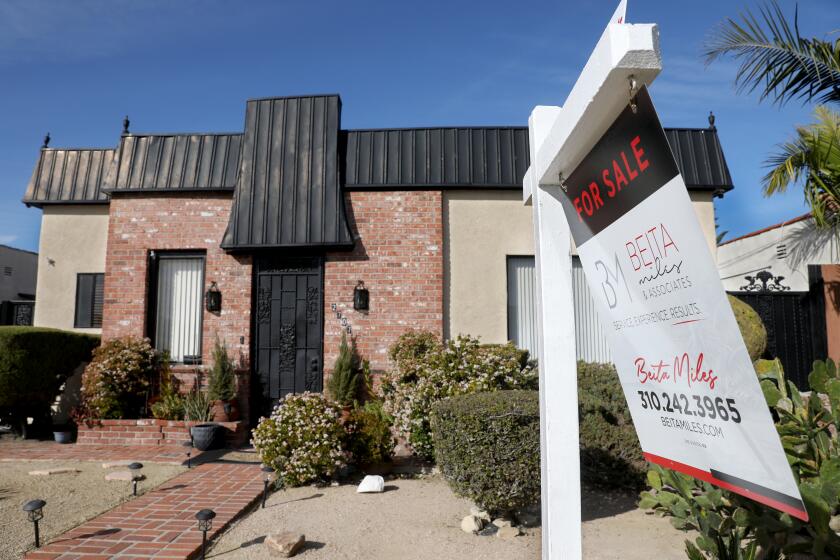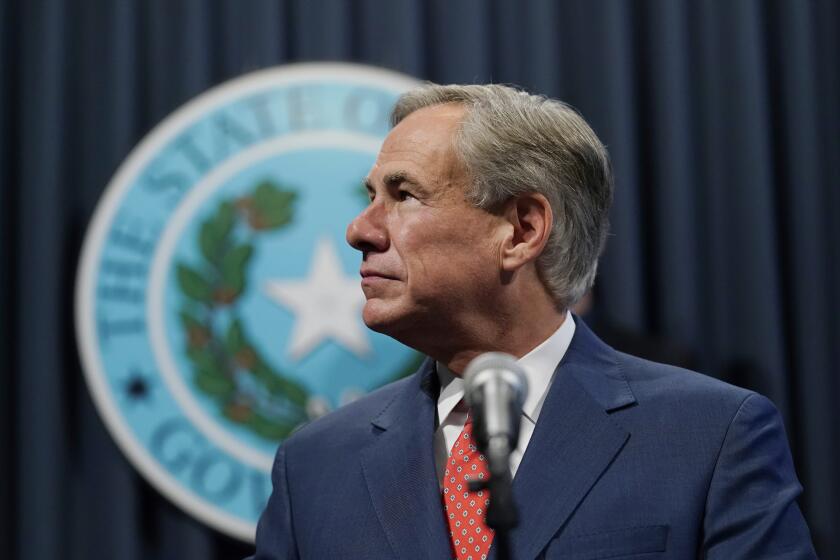Who is to blame for the summer of flight delays and cancellations?

It’s been called the summer of “revenge travel” — a time when Americans who stayed home for the last two years because of the pandemic are splurging to book their dream vacations to make up for lost time.
But that surge in demand, coupled with an understaffed airline industry, severe storms and COVID-19 outbreaks among pilots, flight attendants and mechanics, has created a summer of chaos travel.
Flight cancellations and delays have been surging, especially during heavy travel periods such as weekends and holidays. Since the start of June, nearly 26,000 flights, or 2.2% of all flights by U.S. carriers, have been canceled and 260,000, or 22%, have been delayed, according to FlightAware, a flight tracking company.
“In my 37 years in the industry, I’ve never seen a summer like this,” said William McGee, a former airline operations manager and consumer advocate for the nonprofit American Economic Liberties Project.
So, who’s to blame? There has been plenty of finger-pointing in the last few weeks, aimed at pilots and air traffic controllers, among others. But industry insiders put much of the blame on airline executives who scheduled thousands of additional flights to cash in on the demand this summer. With the workforce awash with new inexperienced staff and plagued by COVID outbreaks, the result has been ugly.
The Southern California housing market is cooling and forcing buyers and sellers to adjust. Here is what you should know if you are in the market.
“A major contributor is that demand has been coming back so quickly and airlines are jumping to try to meet it and overpromising and putting in too much capacity,” said Sara Nelson, president of the Assn. of Flight Attendants-CWA, AFL-CIO.
Airline executives acknowledge that they overcommitted and have reduced capacity by 16% since this spring.
“We’ve taken any growth out,” Delta Air Lines Chief Executive Ed Bastian told analysts during a July 13 earnings call. “We’re positioned not just for the next month or so; we’re positioned for the balance of this year to kind of stay where we’re at. And that level of stability gives the operations the capability to focus on the task at hand rather than continuing to invest and build on growth at the same time.”
The problems are not new. Cancellation and delay rates also soared last summer during and recent holidays when travel demand surged. And passengers are fed up.
“It was so frustrating going around and around,” said Huntington Beach resident Sarah Huoh, who was stuck with her husband and two daughters for nearly 12 hours in Switzerland last week when their flight to London’s Heathrow Airport was canceled at the last minute. The family then missed a connecting flight to Los Angeles International Airport. “No one in the airport would help us. They would just tell us to call the service line, but no one was answering that.”
After she found a flight from London to Dallas, her connecting flight on American Airlines from Dallas to Los Angeles was also canceled. Huoh had to book another flight on American Airlines to Santa Ana.
Carrie Padgett, a tech writer from Central California, was headed to Buffalo, N.Y., on a business trip from Fresno on Sunday when her 6 a.m. flight was canceled. She was rebooked for later that day, but by the time she landed in Buffalo, the shuttle to her hotel had stopped running, forcing her to pay for a taxi ride at midnight in an unfamiliar city.
Given all the cancellations and delays this summer, Padgett said she was not surprised.
“I’d have been surprised to make it to Buffalo without a problem,” she said.
Work from home is what many employees want. But employers still want you back in the office
Frustration with the airlines has been growing for months — even before the summer surge.
The number of complaints about airline service filed with the U.S. Department of Transportation jumped 237% in May, with 4,344 complaints, up from 1,289 complaints received in May 2019. The annual airline satisfaction study by J.D. Power reported in May that satisfaction levels among airline passengers dropped more than 20 points, on a 1,000-point scale, compared with a year earlier. The research and analytics company attributed the decline to a failure by the airlines to manage the increased travel demand.
The frustration among fliers may be aggravated by the rising prices of airline tickets, which have been pushed primarily by higher fuel costs.
In June, the average domestic round-trip airline ticket was $605, a 33% increase over the same month last year, according to Airlines Reporting Corp., which settles ticket sales between airlines, travel agencies and travel management companies.
The airlines’ problems originated in spring 2020, when the pandemic took hold and air travel came to a near-standstill. The federal government approved $54 billion in relief for the airlines on the condition that carriers keep workers on the payroll. But to save cash, many airlines offered pilots, flight attendants and other workers early-retirement packages, which thinned the workforce by thousands.
The overall staffing levels in the U.S. airline industry have rebounded to a level slightly below 2019 numbers. Still, industry experts point out that many recent hires are inexperienced workers who are at the bottom of the learning curve. Expecting them to operate effectively during the summer’s high-demand conditions has been a mistake, they said.
“A large number of new employees are not up to speed or fully trained at this time,” said Randy Barnes, president of Transport Workers Union Local 555, which represents ramp, operations and cargo workers for Southwest Airlines. “On paper the numbers look good, but in practical applications we don’t have all the staff fully trained.”
Southwest Airlines said that it has hired 10,000 employees in 2022 and that cancellation rates have dropped below 2019 and 2020 levels.
“The continued training and onboarding of these employees, along with the hiring of thousands more, is our focus for the remainder of the year,” the airline said.
But other problems remain.
Southern California’s median home sale price dropped to $750,000 in June, another sign that the ultra-competitive market is slowing down.
The pace of training and retraining for pilots has been slower because COVID protocol requires flight simulators to be cleaned and disinfected after each use. Social distancing can be nearly impossible in some cockpit simulators and classes.
COVID outbreaks among air traffic control staff — many of whom work together in cramped airport towers — have also resulted in staff shortages, leading to slowdowns at several airports over the last few months.
Thunderstorms and other extreme weather in the last few weeks have added to the airlines’ woes.
Responding to frustrated fliers, federal lawmakers began last month to put pressure on airlines to fix the problems. Sens. Bernie Sanders (I-Vt.), Edward J. Markey (D-Mass.) and Richard Blumenthal (D-Conn.) wrote to airline executives, urging them to reduce the delays and cancellations.
U.S. Transportation Secretary Pete Buttigieg met virtually with airline executives to discuss the problem. Days later, his flight from Washington, D.C., to New York was canceled.
“I thought, this is pretty on the nose,” Buttigieg told NPR. “It illustrates what millions of passengers are concerned about right now.”
Airlines have at times blamed others for the mess, prompting pushback.
After the Fourth of July weekend, a United Airlines executive suggested in a staff memo that most of the delays and cancellations were due to labor shortages in the air traffic control system.
“Until that is resolved, we expect the U.S. aviation system will remain challenged this summer and beyond,” United’s chief operations officer, Jon Roitman, said in a memo that was published by Reuters and other news outlets.
The Federal Aviation Administration, which oversees the air traffic control system, said United Airlines had confused weather-related problems with staffing issues.
“The reality is that multiple overlapping factors have affected the system, including airline staffing levels, weather, high volume and ATC capacity, but the majority of delays and cancellations are not because of staffing at FAA,” the agency said in a statement.
The Air Line Pilots Assn., which represents 59,000 pilots from 35 U.S. and Canadian airlines, rebuffed the suggestion that a pilot shortage is causing the cancellations and delays, calling it a “narrative that many in the industry are using as a cover for profit-first business decisions.”
More than 8,400 pilots were certified to fly in the 12 months leading up to June 2020 — 1,700 more than in 2019, according to the pilots association.
A trade group that represents the nation’s largest carriers wants the finger-pointing to end.
The airlines have taken responsibility for scheduling too many flights, said Sharon Pinkerton, a senior vice president for legislative and regulatory policy for the trade group Airlines for America.
“I think these are things we have learned, and we’ve taken action based on what we’ve learned,” she said.
The 16% cut in scheduled flights should ease the delay and cancellation problems, as will the hiring of more staff to carry the workload, Pinkerton said, adding that airlines know that travelers are frustrated.
“It’s our brand and our reputation that is on the line,” she said.
Antiabortion and other conservative policies are driving students and high-paid professionals away from red states.











